
Elephanta Caves
Declared a UNESCO World Heritage Site in 1986, Elephanta Caves consists of seven rock-cut caves located on Elephanta Island (or Gharapuri, “the city of caves”), just outside Mumbai Harbour.
The island came to be known as Elephanta because of a huge rock-cut elephant that used to stand on the southern shore of the island and was seen by visitors in medieval times. The British attempted to move the colossal carving to England in 1864, but it immediately broke into pieces and they abandoned their attempts. It was subsequently taken to Mumbai and reconstructed in 1914, and today you can visit it at Jijamata Udyaan (formally known as Victoria Gardens or Rani-cha Baug)

The seven caves at Elephanta are split into two clusters; caves 1 – 5 are on the western hill, and the lesser visited caves 6 and 7 are on the eastern hill. The eastern hill is also known as Stupa Hill, named after a 2nd century Buddhist stupa that crowns the summit, which I also explored and will blog about shortly.
Although partially damaged by time and vandalism, the 6th century carvings at Elephanta are considered to be of the very highest quality, and have inspired awe in foreign visitors ever since the Portuguese arrived here almost 500 years ago.
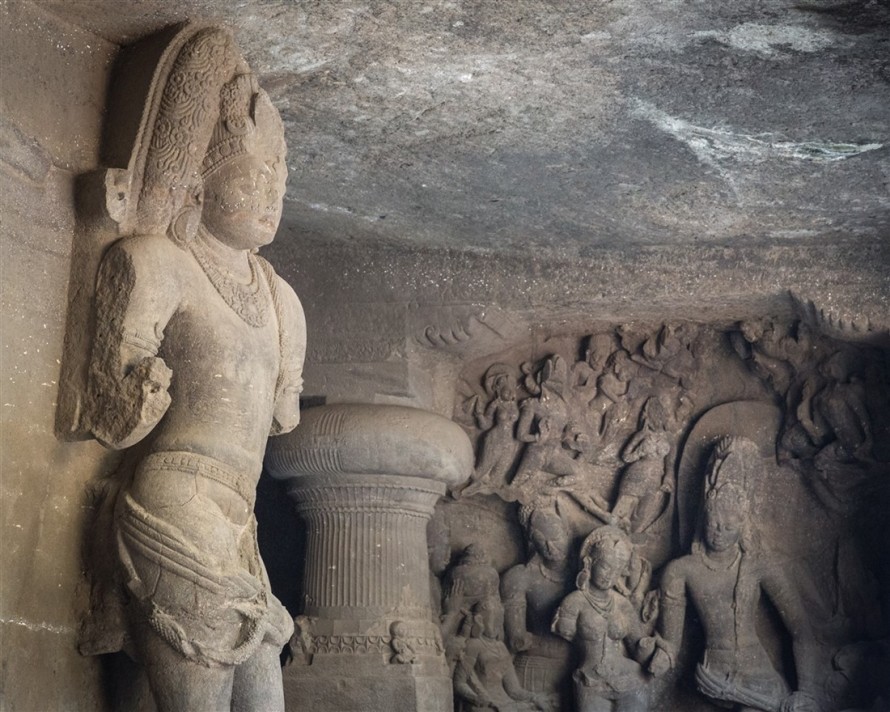
A ferry service from the Gateway of India runs every 30 minutes starting at 9 – 9.30am and takes about an hour to reach the island. You can get further details on this ferry service here.
Having arrived on the island it’s a short but steep climb up 120 steps to reach the main complex entrance, and then on to Cave 1.
Cave 1
By far the most important and famous of all the caves on Elephanta Island, today it is accessed from the north taking you directly into the main cave, but it’s believed the original primary entrance would have been from the east, next to eastern wing.

The cave has a very deliberate geometric layout. It is divided up into 37 bays, separated by columns. The bays are laid out in an inner square of 5 x 5, with a group of three outer bays on each side of this inner square.
There are two key axes running through the cave; a north-south axis leads from todays entrance to an enormous triple-headed Shiva statue, the east-west axis starts from the eastern courtyard, passes through a Shiva shrine and lingam and leads through to the western courtyard.

In the early 1900s six stone sculptures were discovered below ground level in the main cave. The most impressive of these are on display in the Chhatrapati Shivaji Maharaj Vastu Sangrahalaya Museum (abbreviated to C.S.M.V.S. Museum) in Mumbai. If time permits it’s well worth visiting this museum.
Cave 1 is dedicated to Shiva, and as your eyes adjust to the dim light be prepared to be overwhelmed by the scale of volume of the large relief panels that are all over this cave.
What follows is a brief description of each of these panels, starting with the left panel as you enter, and then going clockwise around the cave.
Shiva as Mahayogi or Lakulisa
Now badly damaged, this panel shows Shiva in meditative mood, seated in the lotus position. A very similar panel to this one can also be seen at Ellora Caves. Brahma (with three heads riding a swan) and Vishnu (riding an eagle) are in the top corners.

Some scholars have argued that this panel may actually be representing Lakulisa, the 28th incarnation of Shiva, although despite the damaged nature of the carving there seems little evidence of a lakula (club) which Lakulisa is always depicted holding.
Ravana shaking Kailasa
This is a massive carving showing the king of Lanka, Ravana, being humiliated in the hands of Shiva. Ravana tried to lift Kailash mountain, the home of Shiva, in an effort to carry it to his hometown of Lanka.
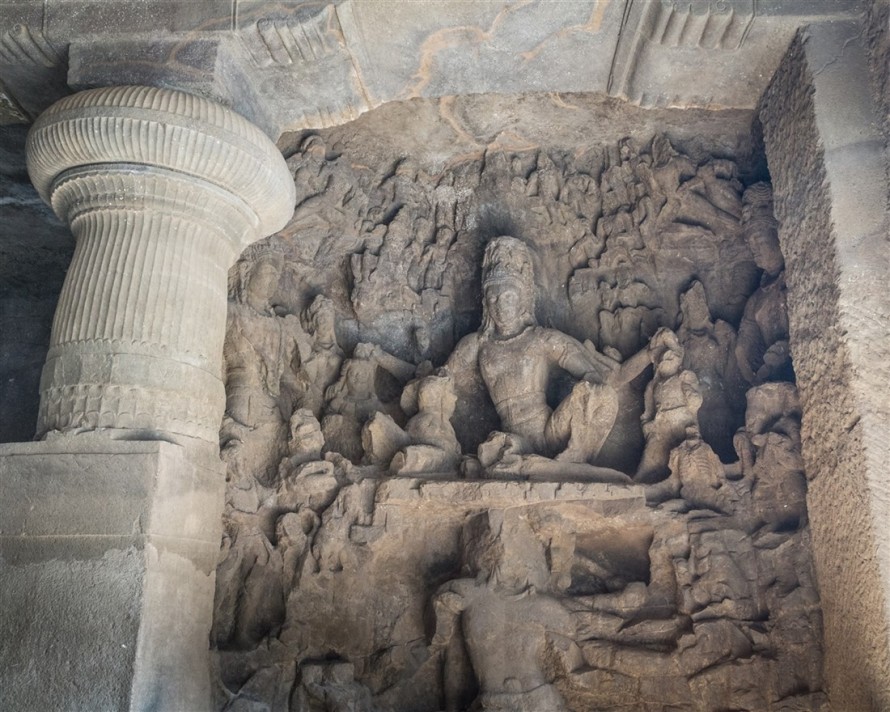
Shiva and Parvati are shown seated on the mountain, one of Shiva’s arms is outstretched to Parvati, possibly indicating that she should not panic. She is seated to Shiva’s left, with Bhringi near his feet and Ganesha and Vishnu also present. The ten-headed, twenty-armed Ravana is at the bottom of the panel, attempting to lift the mountain. Almost identical panels to this can be seen in Cave 16 and Cave 21 at Ellora.
Shiva and Parvati at Kailasha
This is a badly damaged panel showing Shiva and Parvati seated on Kailash mountain. You can just make out the rough outline of a bull, Shiva’s mount Nandi, with some figures either side.

Above Shiva and Parvati are shown various structures, houses and palaces, which represent their home on Kailash
Although now the most damaged panel at Elephanta, a pristine identical panel is again preserved at Ellora in Cave 21.
Ardhanarisvara Shiva
This is a beautiful panel showing Shiva as Ardhanarisvara (part man, part woman), a transformation that allowed Shiva to produce all living creatures. Notice how the female side (representing Parvati) has more jewellery, with accentuated hip, single large breast, as she looks into a mirror.

On the male side, one of Shiva’s many arms is resting on a wonderfully naturalistic carving of a Nandi. There’s also Kartikeya (Shiva’s son) riding a peacock, Brahma riding swans, Visnu on a Garuda, and Indra riding his elephant. Ardhanarisvara is considered the ultimate concept of the union of male and female.
Sadashiva / Mahesha / Trimurti
It’s hard not to enter cave 1 and immediately head for this carving, it is utterly spectacular. Carved on the back (south) wall, exactly opposite the main entrance, is the three-headed bust of Shiva, identified as Mahesa, Mahadeva, or Sadasiva. Often thought as representing the Trimurti, it is colossal, measuring nearly 6m high on a 1m high platform.

It is awe inspiring, carved into a deep recess the image projects forward, benefiting from a little light provided by the entrance opposite.


The central head has a benign expression, eyes almost closed in what appears to be a deep meditation.

The right face (left as viewed) is thought to present Aghora, Bhairava or Rudra, the “destroyer” aspect of Shiva. With a curled moustache, bearded, hooked nose and somewhat gruesome appearance.

The third head (right as viewed) is thought to be Vamadeva, the preserver of the universe with a peaceful demeanour, eyes closed, and again in a trance like state. Note how each face has it’s own expression, jewellery and headdress.

Flanking the giant bust are guardians, each with a dwarf attendant, appearing calm with eyes half closed.
Gangadhara Shiva
Immediately to the right of the Trimurti colossus is a panel narrating the complex story of the descent of the Ganga. This 4.8m high Shiva is shown with four hands, one potentially touching the chin of Parvati, although it has now been broken. This gesture may reflect the jealousy of her as Ganga is descending into the locks of Shiva and will reside there as her rival in love.

Although this panel has huge proportions, both Shiva and Parvati have slender forms and both stand in a triple-flexed posture. This is the only panel which has the lower parts of the bodies are intact.
Kalyanasundara-murti
This panel depicts the marriage between Shiva and Parvati. The figure of Shiva is nearly 3.5m tall, with a much smaller Parvati standing to his right, the customary place for a Hindu bride at a wedding.

Behind Parvati is her father, Himavat, and the female figure next to him is believed to be Parvati’s mother, Mainavati. Brahma adopts the role as priest for the ceremony, with Vishnu witnessing the event riding his Garuda mount.
Central Shiva Shrine
Located on the western half of the great hall, the Shiva shrine is square in plan with doors on all four sides. Each entrance has a flight of six steps, guarded by amazing 4.5m tall colossal guardians (dvrapalas).

For me this is definitely one of the highlights of my visit to Elephanta. The shrine is close enough to the western wing to offer some brilliant play of light onto these carvings, which are the tallest at Elephanta.
Although quite badly damaged, they stand in a lively half-flexed position all wearing a crown. The most complete example stands at the south-east corner of the shrine.
As you climb up to the sanctum, note the sockets chiselled into the rock, which must mean at one time wooden doors existed here.


The sanctum has a plain interior with a lingam fixed on a rock-cut pedestal.
Andhakantaka-murti
This panel shows an angry eight-armed Shiva, face filled with rage, annihilating the demon Andhaka.

Notice the skull set in his headdress, and just how dynamic his posture is. Unfortunately only three of Shiva’s hands have survived, the remaining are missing from below the elbow.

In the surviving right hand is a sword, in the left hands are a trident which is thrust into the belly of the demon, and a bowl for collecting the blood dripping from the demon’s body. Pretty gruesome stuff.

Most of the figures either side of Shiva have been destroyed, but you can just make out the head of an elephant behind the sword.

The top of the panel has a number of figures, possibly devotees offering worship to a central shrine. Initially this shrine looks like a Buddhist stupa, but it surely has to be a lingam. The devotees appear to be couples hovering in the sky, bringing offerings of flowers.
Nataraja Shiva
Upon entering the cave this panel is immediately on your right, and concludes the circular tour around the panels of the main cave.

Although now considerably damaged with the lower part entirely lost, it shows Shiva as Lord of the Dance. Seven of his eight hands have been broken, but despite the condition it is still a hugely impressive work of art.
Shiva is surrounded by numerous Gods and attendants, including Ganesha, Parvati, Vishnu, Brahma, Bhringi, and Indra.
Western Wing
Outside the western entrance, behind Shiva’s shrine, is a rock-cut courtyard. On the south side of the courtyard is a water cistern, which in 1923 produced a copper vessel engraved with an inscription and dated to 1068 A.D. To the west is a further Shiva shrine with a lingam installed.
On the north wall of the portico is Shiva seated on a lotus stalk supported by two figures and attended by devotees. A similar panel also appears on the south wall.
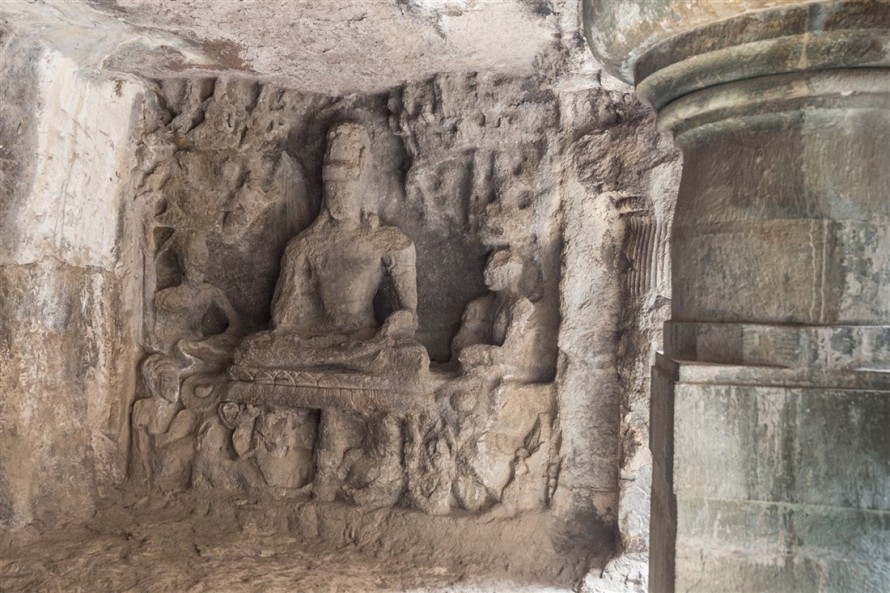
It is believed both the western and eastern wings are slightly later than the main cave, probably added in the 7th century A.D.
Eastern Wing

To the left of the eastern entrance of the main cave is another shrine, with a square sanctum and attached hall in front. The plan of this wing is similar to cave 21 at Ellora, with the sanctum housing a stone lingam complimented by a circumambulatory passage.

On either side of the passage are massive guardians, each with attendants, and having a third eye.

The entrance to the shrine is guarded by two lions, the head of one of them was broken by a European visitor in May 1868.
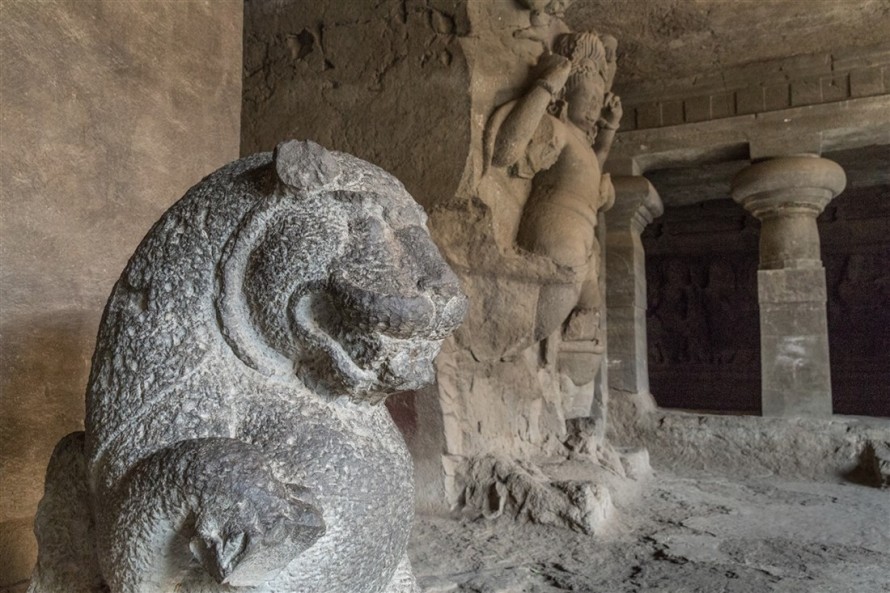
There are also two further panels; Kartikeya on the northern wall and Ganesha on the southern side.
Many visitors to Elephanta Caves don’t venture beyond cave 1, it is after all the only cave that is profusely decorated with sculptures. However, caves 2, 3, 4 and 5 are right next door, and still worth a quick look if the energy levels permit.
Cave 2
Cave 2 consists of a portico with four pillars, and two small cells beyond. For whatever reason, this cave was unfinished. The front of this cave was completely destroyed and restored in the 1970s.
Cave 3
Cave 3 has an oblong hall with six pillars, and three cells cut into the back wall. The door to the sanctum is flanked by badly mutilated guardians.
Cave 4
Similar in plan to cave 3, it has a large veranda and a shrine containing a lingam. The shrine is flanked by more guardians, now in very poor condition.
Cave 5
Another unfinished excavation, but this one at a much earlier stage. I can only assume that perhaps a fault was found in the rock that prevented any further work from taking place here.
—————
The remaining two caves at Elephanta are a 15 minute walk away on the opposing eastern hill, known as Stupa Hill. To reach them you need to exit the main caves complex and turn right immediately before starting to descend the stairs back down towards the jetty.
This path descends slightly and takes you to a dirt road, you need to continue straight ahead, crossing the road, and start ascending a path on the opposite side. Although lined with ancient rocks, the path is not very clear, so the following two photos will help you get on the right track. Clearly not many people attempt to visit caves 6 and 7.
This steep and sometimes twisty path climbs up on to Stupa Hill, keep an eye out for the rocks lining the path as this will ensure you’re heading in the right direction, although the vegetation often obscures them. After about 10 minutes you will reach Cave 6 on your right.
Cave 6

You will almost certainly be the only person here, and it’s wonderfully peaceful.
Cave 6, known as Sitabai’s temple cave, consists of three chambers with a portico. Interestingly this cave was converted into a church by the Portuguese when the island was a part of their colony. This also happened at Mandapeshwar Caves in downtown Mumbai.
Cave 7
Continue ahead on the same path as before, the rocks are still there to guide you, but the path becomes less clear all the time. Cave 7 is quite well hidden and easily missed as the path actually goes over the roof of the cave ! Look out for a clearing on your left, the photo below will hopefully help you find it.

This cave is also unfinished, it was abandoned following the discovery of a flaw in the rock.
For those of an adventurous nature and with some reserves of energy, the path continues ahead towards an unexcavated 2nd century A.D. Buddhist stupa that crowns the hill.
It probably comes as no surprise to you that I did set off in my search for that stupa.
—————
If you are planning to visit Elephanta Caves my main advice would be to do it on a weekday, and to get the first ferry out of Mumbai in the morning. The caves will get very busy whenever you chose to go, but by getting there early you stand a chance of seeing most of cave 1 before too many subsequent ferries and people arrive on the island.
I would also recommend a visit to Jogeshwari Caves in Mumbai, believed to be the first Hindu cave temple in India, it’s very much the precursor to Elephanta Caves having been built just 50 years earlier. It has nothing like the impressive sculptures of Elephanta, nor does it have a comparable setting. But it will help you appreciate how the architecture of these caves developed during the birth of Maharashtra’s strong tradition of excavating rock-cut temples.
You’re welcome to ‘Like’ or add a comment if you enjoyed this blog post. If you’d like to be notified of any new content, why not sign up by clicking the ‘Follow’ button.
If you’re interested in using any of my photography or articles please get in touch. I’m also available for any freelance work worldwide, my duffel bag is always packed ready to go…
KevinStandage1@googlemail.com
Categories: Elephanta Caves, India, Maharashtra, Mumbai













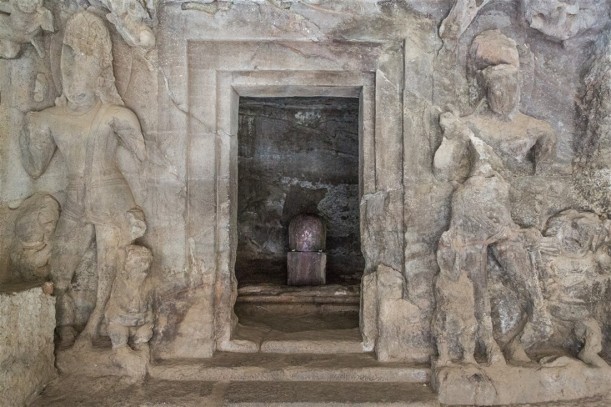
























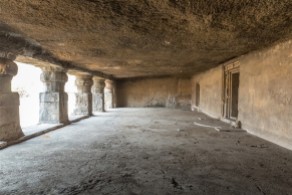



The lighting of the Shiva Linga in a couple of the photos was stunning. Neat place!
LikeLiked by 1 person
Thanks, glad I finally got around to visiting these caves !
LikeLiked by 1 person
Very interesting. I’ve been to the caves several times but didn’t know much about them until I read this piece. I didn’t even know of the existence of caves 6 and 7! Will have to look out for them when I visit next.
LikeLiked by 1 person
Loved the post and photos
LikeLiked by 1 person
Thanks !
LikeLike
Informative and absorbing. Looks as if you had the place all to yourself!
LikeLike
Not quite, but got there early to avoid the main crowds 😀
LikeLike
Thanks for the detailed travalogue..and super snaps.will have to visit elephanta caves at the earliest.
LikeLiked by 1 person
I found cave no. 6 by following your guidance. Thanks.
LikeLiked by 1 person
You’re welcome, well done, not many people venture that far
LikeLike